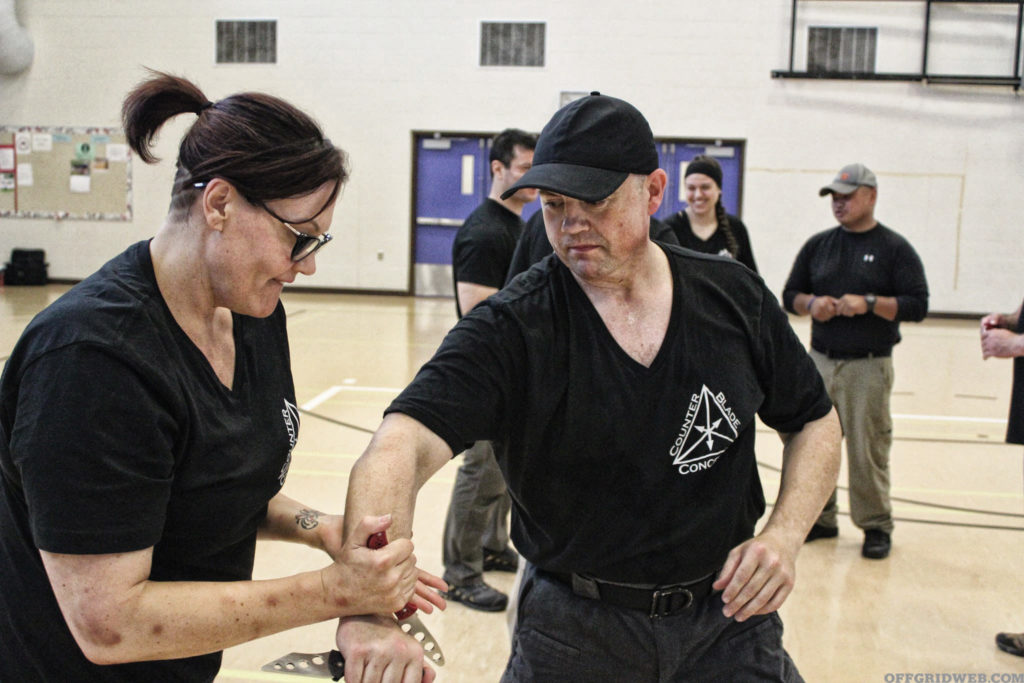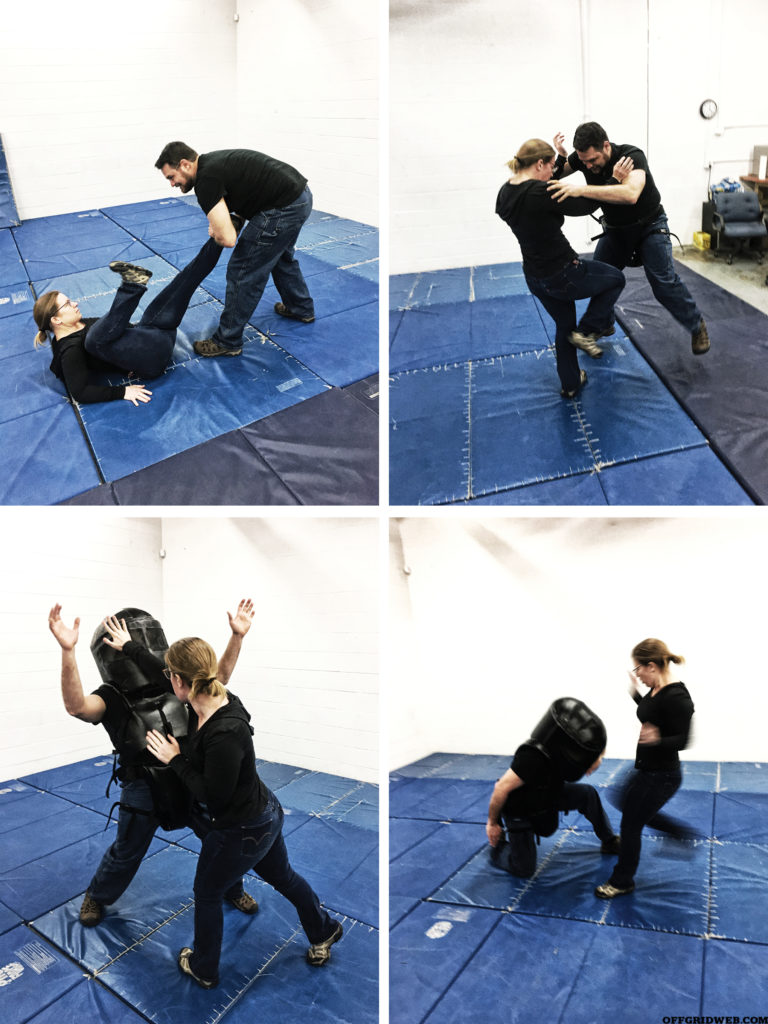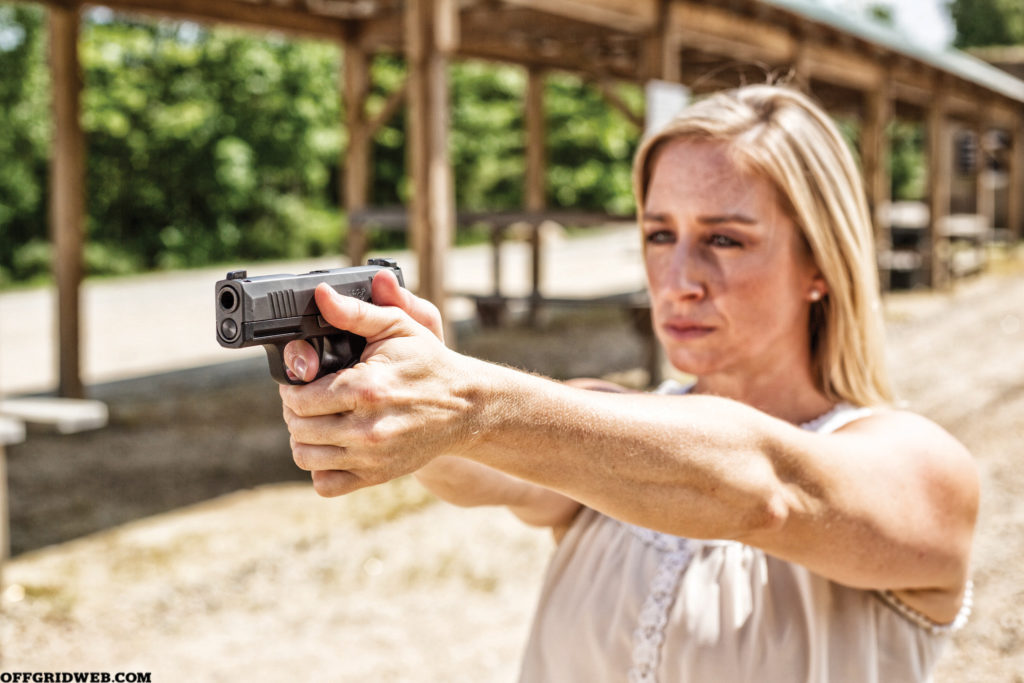RECOIL OFFGRID Survival Self-Defense Against Sexual Assault
In This Article
Watch any TV show about criminals and the people who catch them for long enough, and you’ll inevitably see an episode that begins like this: A lone woman out for a jog early in the morning, or drunkenly walking to her car after a night at a club, is suddenly not alone. She may not know it — she might have headphones on or be fiddling with her phone — but we, the viewers, see her stalker appear. He — burly and indistinct, maybe wearing a ski mask or hoodie — slinks out from behind a tree or a parked car and creeps up behind her, weapon in hand. She might notice him just in time for a cut-off scream, or the scene might just fade to black. In film, we see sexual assault coming from miles or minutes away.
The next time you see this woman, she’ll either be in a hospital bed, or detectives will be crouching over her body searching for clues. In rarer scenarios, her screams will attract attention from other people who come to the rescue, or she’ll manage to fight him off herself and immediately report the incident to the police.
There are a lot of dangerous misconceptions about sexual assault in this country. Some of them exemplified by the situation above. There’s an idea that rape is perpetrated by strangers, that it only happens when people don’t pay attention to their surroundings or let themselves get drunk, or that they’re bringing the risk on themselves by being in the wrong place, dressed the wrong way, at the wrong time of night.
Other common myths are that rape and sexual assault are rare, that it’s a thing that only happens to women, and that it always results in easily perceptible violence. After all, can a person have been raped if they don’t show signs of a struggle? If they didn’t even fight back? Can we call it rape if they were drunk, or high, or said “yes” at the beginning of an encounter and only switched to “no” once things were already underway?
Data collected by the Department of Justice and the FBI over decades show that rape and sexual assault are crimes experienced by 1 in 6 American women and 1 in 33 men. Eight out of 10 rapes are committed by someone known to the victim, usually either an acquaintance or a former/current partner, and over half of all rapes take place in or near the victim’s home. In cases of sexual assault against a juvenile, the percentage of crimes committed against them by someone they know is 93 percent. The use of weapons in sexual assault, apart from the assailant’s own hands and feet, is relatively rare — 11 percent total, and slightly more guns than knives.

Data collected by the Department of Justice and the FBI over decades show that rape and sexual assault are crimes...
The truth is that for most victims, rape and sexual assault aren’t random acts of violence. They’re typically perpetrated by someone the victim knows — the hookup who had some time alone with her drink, the person in a position of authority she doesn’t feel she can say “no” to, such as a prison guard, or maybe the roommate’s boyfriend who keeps hanging out in their dorm room. This degree of familiarity brings a lot of complication with it. It’s easy to visualize violence against a predator you’ve never met before, but much harder when it’s someone you know, someone who your family likes, someone you thought you were friends with, or someone you might have to see and deal with every day.
According to the Bureau of Justice’s National Crime Victimization Survey, rape is one of the least-reported crimes in America. Out of every thousand cases of sexual assault identified in this survey, 230 were reported to police, 46 reports led to arrests, nine cases got referred to prosecutors, and only five cases led to a felony conviction. Hundreds of thousands of rape kits containing crucial DNA evidence sit untested in evidence rooms or crime labs because detectives or prosecutors haven’t requested the data, or the crime labs are overwhelmed. There are no federal laws mandating the tracking and testing of rape kits, either. To someone already suffering from insecurity over whether or not they’ll be believed if they report their assault, numbers like this are discouraging.
The prevalence of rape and sexual assault have noticeably dropped over the past several decades, and thanks to movements like #MeToo, the issue is a larger part of our social discourse than ever before. RECOIL OFFGRID has assembled a panel of experts in the field of women’s self-defense to cover common questions about how to prevent and protect yourself from sexual assault. This panel consists of myself, martial arts trainer Cath Lauria; SIG Sauer Director of Training and Special Events Hana Bilodeau; and Rhonda Lent, who also has a background in law enforcement.
What verbal de-escalation techniques can be used to thwart an attack, and what’s the overall role of psychological self-defense?
CL: The most effective de-escalation techniques start early, and they don’t even have to be verbal to work. Setting and maintaining boundaries is the best thing a person can do to help protect themselves against assault before things get physical. Does that drunk guy at the office holiday party keep coming up to you asking for a hug? Offer a handshake instead. If he insists, tell him you’re just not interested in a hug, thanks. What if he calls you a bitch? Well, who cares what he thinks, as long as you’re safe.

If things get to the point where threats are being made, where physical boundaries are being crossed, and where you feel unsafe — this is the time for more forceful de-
escalation techniques. Volume goes up, hands go up — put a physical and a sound barrier between you. You don’t have to curse and threaten in turn, and it’s better if you don’t. Be clear: Tell them to back off, to leave you alone, shout for others to call the cops. Do this loudly. You want people to hear you, to rip away the veil of privacy and secrecy the assailant is trying to create. If they continue into physical assault after this? Then, it’s all systems go, because you know that you’ve done your best to de-escalate the situation by letting them know that attacking you is going to be a big mistake.
HB: Verbal de-escalation is an invaluable skill. As was discussed in the article, despite common misconceptions, most sexual assaults occur by someone known by the victim. Because of this familiarity, most often there’s a grooming phase prior to the actual assault. Due to manipulation on behalf of the suspect, the victim is often left confused and scared and, in many instances, doesn’t verbally or physically resist. Because of the shame that the abuse leaves behind, we find a large majority of victims don’t report the abuse immediately, if at all. It’s the responsibility of modern society to fight the root of the problem if we intend on making a notable difference. We need to breed into our youth body positivity and respect. Teach them to have a voice and how to use it. Whether a stranger or a trusted loved one, implementing “verbal Judo” could potentially be the defense that changes the outcome.
RL: I’ve been accused of “victim blaming” when discussing the development of soft skills. This is what I always say, and I will say it again. If we lived in a perfect world, we wouldn’t have to lock our houses or lock our cars. If everyone had the same moral and ethical compass and 100 percent abided by a set of rules, we wouldn’t have to take measures to protect our personal belongings from theft. The same logic applies here. The purpose of developing hard and soft self-defense skills is to minimize risk.

If the threat isn't imminent, be clear on how you want things to unfold. Self-confidence is key to verbally and nonverbally delivering what your needs are in that moment. This is about creating boundaries and is an excellent way of testing the waters in how logically the other person will respond.
Say “NO!” loud and clear. This will tell the attacker that whatever happens from that point forward isn’t consensual. When a threat is imminent, you’re past the point of verbal de-escalation. This point requires action. Look around for avenues of escape — if you can escape safely, do it! If you cannot safely escape, you must assess whether or not it’s feasible to physically fight off the attacker.
It’s worth noting that internet safety applies here, especially in the event that you’re meeting up with someone in person who you have only spoken to via internet, text, or email. If you’ve met someone who’s a friend of a friend, those soft skills and being mindful of safety applies here. Meet in a public place, don’t share your personal address, and don’t meet in a place that puts you in danger until you really know what they’re about. Take note of avenues for a safe escape and remove yourself from the situation. If those skills have already been applied and things lead in a direction you’re not prepared for, the next point applies to you.

If you get the sense that something isn’t right, listen to your gut. Intuition is a primitive survival mechanism. Don’t allow your brain to convince you that your gut feeling isn’t warranted! Get beyond a possible mentality of “it won’t happen to me.”
SELF AWARENESS: Understanding what your limitations are and what you’re capable of doing under stress will empower you to know how to handle the situation in a confident way.
SITUATIONAL AWARENESS: The development of this skill is a means to avoid the situation before things escalate. Awareness of your surroundings and a person’s behavior can tip you off on what’s about to happen.
WHEN-THEN THINKING: This is a great technique to psychologically and physically prepare for a threat. This is also known as “scenario planning” and “scenario thinking.” It’s not only a means to address your physical skills and pressure test them, but it’s also a way to think about all kinds of scenarios that you might find yourself in and problem solve them. The benefit is to be able to break things down, without stressors, in order to look at things from a place of logic and analysis. Create a list of what you’d do. This technique creates a “file” in your brain that lets you know that you’re familiar with the situation, if one of those situations occurs. You’ll be able to respond with more confidence and go through the steps necessary to handle it. If you create that scenario in a safe training environment, you can also take note of where things went wrong, remediate them, and execute the actions repeatedly to “hardwire” your response to make it second nature.
What are some of the best techniques you’ve found that a person can use to effectively defend themselves once the attack has begun? How can martial arts enhance basic self-defense skills? Given that most rapes are perpetrated by people the victim knows and take place in their own homes, how do you feel about the use of weapons in a rape defense context, and what type of weapons training is appropriate?
CL: If it comes to the point that an attack is unavoidable and you’re fighting back, remember that the best targets are the ones that can’t be strengthened with steroids. The face — the eyes in particular — and the groin are excellent targets, and a strike there doesn’t require a lot of force to be painful. You don’t even have to hit the eyes or the groin square on to get someone to back off — the body’s flinch response is built-in. As for the old saying that you should never hit a guy in the groin because it’ll just make them madder … it’s true, it will make them mad. It will also be really, really painful, so let them be mad and doubled over holding their junk while you get to safety.
The best thing that martial arts and combatives training can bring to a basic skillset is a better understanding of how to deal with and use adrenaline. Your adrenaline is triggered in assault situations — the fight-or-flight response becomes engaged, and when that happens a lot of fine motor skills go out the window. Gross motor movements are your best bet and practicing those skills under the effect of adrenaline is an excellent way to improve your chances of actually remembering how to protect yourself once the fight is on. It’s imperative to have a basic understanding of grappling and ground skills as well, given that all rapes take place at extremely close range. People don’t become rapists because they want to go toe-to-toe with someone — rape is a crime of power, revolving around being able to intimidate and control someone else. The harder it is to control you, the less inclined they’re going to be to try.

Martial Blade Concepts instructor Rhonda Lent is shown here teaching a student edged-weapons combatives techniques.
A case in point: A friend of mine in the Peace Corps was attacked while she was sunbathing on a beach. The man tried to get on top of her, she kicked and hit and screamed like a banshee, and he fled in under a minute. She wasn’t a trained martial artist, but she had talked to me and my husband about the basics of self-defense, and she remembered enough of our advice to make her assailant think twice.
As for the use of weapons in cases of rape defense, my initial response is to say: Use whatever you’ve got. If you carry a weapon or have something makeshift on hand, and you can access it and use it without putting yourself in more danger, great. However, weapons aren’t a panacea. Do you want to risk using a gun in your own home, if it means you might hit someone else in the house? Do you want to bring a knife into the situation even if you haven’t trained with it, just because you hope it looks intimidating? You won’t help yourself by fumbling it, and the last thing you want is for your own weapon to be used against you.
HB: I’m not sure we can appropriately categorize “best techniques of defense,” as every victimization is different and individualized to that specific victim. What I do think we can say is martial arts and self-defense training are known to enhance one’s self esteem and awareness of a person’s physical capabilities. Having this training undoubtedly could aid in a hand-to-hand situation.
RL: As far as techniques go, and I know that RECOIL is well informed on this system for good reason, I’m partial to Martial Blade Concepts (MBC), founded by Michael Janich. MBC and its subsystems will give the practitioner concepts on how to defend against a particular angle, based on zones of defense using structure, rather than muscular strength. For this reason, I favor this system as a female, considering most male subjects will be larger and stronger than me. MBC also includes topics on situational awareness, avoidance, and de-escalation, which is an indicator of a well-rounded system.
If you are looking for something to train, look at the system in its entirety and figure out if it’s a good fit for you. You have to be prepared to meet violence with violence. Attacks to the eyes are a great means of creating a window of opportunity for escape.

Martial artist Cath Lauria demonstrates takedown techniques on a would-be assailant during an exercise to simulate a...
Martial arts can enhance basic self-defense skills by:
Building character, as practice in a martial art can provide you with a mentor who inspires specific character traits, leadership, and physical skills.
Creating self-discipline. There will be times when you don’t feel like training and you would rather do something else, but because you’ve made a commitment to training in that martial art, a commitment to your peers, and commitment to your leadership and mentors, you go!
Creating a foundation of body awareness. When I teach, a large amount of my time is spent on how to move the body in an efficient way. Training in a martial art will naturally provide this skill. You are able to make that mind and body connection, create coordination, and understand how to generate power when necessary. On the flip side, body awareness will also teach you what your physical limitations are. Understanding what you are physically capable of is paramount in the application of self-defense.
Training has an enormous impact on our psyche as individuals, along with a physical skill set. The above skills create self-confidence. Training in a martial art takes dedication, and not everything is easy. You have to work for your successes, learn from your failures, and learn the value of never giving up when things become challenging. This confidence will filter into who we are as a human. It instills empowerment for us to stand up for ourselves.
Disclaimer: I am not American. I live in Canada, where there are significant limitations on what can be legally carried. So, what I use and carry possibly differs from many of the readers of RECOIL magazine. What I would advise is to use a weapon that you are most comfortable with, competent with, and one that you can legally justify using. If you opt to use a weapon, make sure you learn how to use it proficiently, under stress, and in dynamic situations that will best replicate times where you may need to use it. You must understand the weapon’s capabilities and limitations.

As director of training and special events for SIG Sauer Inc., Hana Bilodeau is a huge advocate for self-defense...
How do you feel about compliance theory? Is there a time when compliance is the appropriate response in a sexual assault situation?
CL: Firstly, I want to make it clear that even if a victim is threatened, coerced, or drugged into complying with assault, that doesn’t diminish the fact that they were sexually assaulted against their will. The only person who can make the call about how to resist in the moment is the victim. If they feel that compliance is their best chance at getting through the situation with the least amount of harm, then that’s their choice and it should be respected.
In essence, though, compliance is already at work in the vast majority of sexual assault cases, because these victims are capitulating to the threat of greater violence if they don’t comply. Rape is a crime largely predicated on the premise that the victim will be compliant. Given the prevalence of rape in our society, compliance as a strategy isn’t working to solve the problem. The best option in the vast majority of cases is to upset the predator-prey dynamic by fighting back immediately and vigorously. If you are going to fight, then be prepared to commit fully from the beginning. By the time the situation gets physical, a number of boundaries have already been crossed and there is no longer any room for half-measures.
HB: Is compliance theory an appropriate response to a sexual assault? I think it is very common for people to think to themselves “I would never comply,” “I will not be a victim,” “I will fight.” However, until it actually happens, no one can speculate how it will transpire, what the victimization entails, or how one will respond. Having investigated hundreds of abuse cases over my career, I can honestly say that in some instances, compliance was the answer to the victim’s survival. Are there other methods that work? Absolutely! But the methods of defense used are very specific from case to case.
RL: Frankly, it doesn’t matter how I feel about the compliance theory. The bottom line is that in this particular scenario, the victim knows their personal level of training, has their own sense of situational awareness, the realities of their physical abilities and limitations, and their perception of the threat. The victim is led to make a decision to fight off the subject or to physically comply while making it clear that they are not consenting. Only the victim can determine if compliance is a valid option for them.
What do you think people should know about post-incident response? What options should victims be aware of, and what steps should they take, in terms of legal, medical, and psychological care?
CL: The decision to report a sexual assault can be a complicated one. There are a lot of reasons a person might not want to report the assault — maybe the attack was interrupted or the assailant stopped before finishing the assault. Maybe the victim and the attacker have been intimate before, and the victim feels like this lessens their credibility. Maybe they don’t have any physical injuries and are worried about providing enough proof, or are concerned about getting into trouble of their own for breaking a rule when the assault occurred — say, a teenager getting drunk before it happened.
One thing to keep in mind is that in the Unites States, thanks to the Violence Against Women Reauthorization Act, a person can have a sexual assault forensic exam, otherwise known as a rape kit, done anonymously, only identifying the victim with a code. That anonymity can be dropped later on if the victim decides to report the crime. That being said, there is a time limit on reporting to the police, which can vary from state to state.
One excellent resource for assault survivors is RAINN (Rape, Abuse & Incest National Network), who run the National Sexual Assault Hotline (800-656-4673) which, among other things, can help them find a local health facility that can perform a rape kit. They can also get them in touch with local sexual assault service providers who can offer information and resources for counseling, victim advocacy, hospital accompaniment, and emergency shelter, among other things. Their website (www.rainn.org) also has a breakdown of the statutes of limitations on different sex crimes in different states. In the end, the most important for a victim of sexual assault is to be safe with people who care for and believe them.

Taking proper steps to report, seek medical attention, and mental health care are extremely important steps in taking...
HB: Post incident, I think that it’s very important for victims to know that the reporting process is just that: a process. I also think it is important to acknowledge that the criminal justice system is not a place for closure for victims. Taking proper steps to report, seek medical attention, and mental health care are extremely important steps in taking back control of your life. This will aid in transitioning the mindset from victim to survivor.
RL: Two things about post-incident response: understand what your body may go through immediately following the incident and know what steps to take to report the rape.
First, understand that what has just occurred is physical, emotional, and psychological trauma. The sympathetic nervous system (SNS) has been triggered, therefore, many symptoms may arise. The body has to eventually return to its regular state, which will have its own set of symptoms (for you curious readers, have a look at the parasympathetic nervous system). Both sets of symptoms include vasoconstriction and vasodilation. This is why serious injuries can go undetected until vasodilation has occurred. This means that the veins will dilate, rushing blood back into the extremities, post event.
Second, call a family member or friend for support. Get assessed by a medical professional asap, not only for the assessment for injuries, but also to have a rape kit completed. Report the incident to law enforcement in the appropriate jurisdiction. Contact a legal professional. Talk to a mental health expert to process the trauma. If you are unsure where to start, complete an internet search for post rape resources available in your area.
For more reading on self defending against sexual assault and abduction, check out this article written by a 16 year veteran law enforcement officer.
Hana L. Bilodeau has over 15 years of law enforcement experience, serving both locally and federally. Hana spent a large part of her local career in the detective unit investigating crimes against people, predominantly sex crimes. She was well known for her interview skills of both victims and suspects garnering multiple convictions. Hana has a wealth of knowledge in a number of different defensive modalities and presently serves as director of training and special events for SIG Sauer Inc.
Cath Lauria has been a women’s self-defense instructor for over 20 years, working with both Model Mugging and Fast Defense, which specialize in adrenal stress conditioning. She has multiple black belts and is a Certified Associate Instructor in Martial Blade Concepts.
Rhonda Lent has been employed by a state-level law enforcement organization for the past 22 years. Her experience includes membership in a tactical unit, control tactics, communication, and use of force. She currently works in a law enforcement oversight capacity. She privately facilitates training in Michael Janich’s Martial Blade Concepts and its related systems as the first and only female Certified Full Instructor, worldwide.
 STAY SAFE: Download a Free copy of the OFFGRID Outbreak Issue
STAY SAFE: Download a Free copy of the OFFGRID Outbreak Issue
No Comments